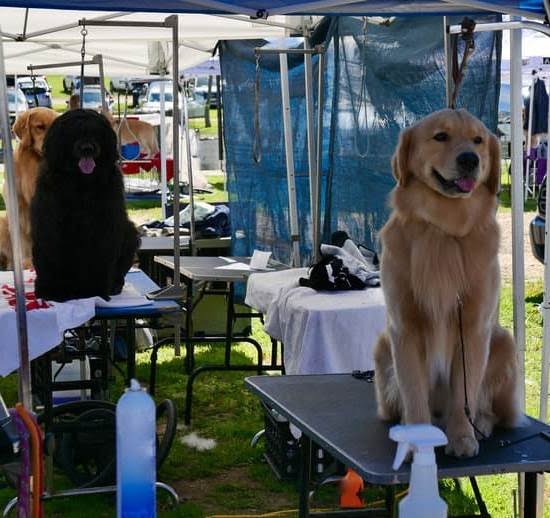Are you passionate about saving lives and working closely with man’s best friend? If so, then becoming a search and rescue dog trainer may be the perfect career path for you.
In this exciting world of search and rescue dog training, trainers play a crucial role in training dogs to locate missing persons, provide assistance during disasters, and bring hope to those in need. In this introductory section, we will explore the importance of search and rescue dog trainers in saving lives and briefly explain the requirements and skills needed for this rewarding career.
Search and rescue dog trainers are instrumental in helping find missing individuals, whether it be lost hikers in the mountains or victims trapped under rubble after natural disasters. Their ability to train dogs to track scents, navigate rough terrain, and perform specific tasks can mean the difference between life and death. With their expertise, trainers guide both canine partners and human handlers through intense training programs that culminate in highly skilled teams capable of handling even the most challenging situations.
To become a search and rescue dog trainer requires not only a love for dogs but also a diverse skill set. Trainers must possess excellent communication skills, an understanding of canine behavior, problem-solving abilities, as well as physical fitness.
They must be able to think on their feet, adapt quickly to changing conditions, and remain calm under pressure. Additionally, trainers often work in various environments such as forests, mountainsides, urban areas or disaster zones; they must be prepared to face these different challenges while ensuring the safety and effectiveness of their canine teams.
In the following sections of this article, we will delve deeper into all aspects of becoming a search and rescue dog trainer. We will explore the role and responsibilities of these professionals, discuss the necessary education and training options available for aspiring trainers, examine essential skills required for success in this field, navigate certification processes required by industry standards while providing advice on building a successful career.
Whether you are just starting your journey or looking to further develop your skills, this article will serve as a comprehensive guide to help you pursue your passion for search and rescue dog training.
What Does a Search and Rescue Dog Trainer Do?
The Role and Responsibilities of a Search and Rescue Dog Trainer
Search and rescue dog trainers play a crucial role in training dogs to assist in locating missing persons, disaster victims, or even evidence at crime scenes. Their main responsibility is to transform these incredible animals into highly skilled search and rescue companions. This involves teaching the canines a wide range of skills, including tracking scents, obedience commands, agility exercises, and even specialized tasks like avalanche or water rescue.
In addition to training the dogs themselves, search and rescue dog trainers also work closely with their human handlers. They educate handlers on how to effectively communicate with their canine partners and build a strong relationship based on trust and respect. Trainers often provide guidance on search techniques, navigation skills, safety protocols, and the overall management of search operations.
Tasks and Environments
Search and rescue dog trainers have diverse tasks that vary depending on the specific focus area or organization they work with. These professionals may be involved in training dogs for wilderness searches, urban disaster scenarios, cadaver detection missions, or even uncovering evidence at crime scenes. Some search and rescue organizations also train dogs for specialized tasks such as finding survivors buried under rubble or those trapped in vehicles.
The environments in which search and rescue dog trainers work are also extremely varied. They may find themselves navigating through thick forests during a wilderness search operation one day, while the next day might involve urban settings like collapsed buildings after an earthquake. Trainers must adapt to different terrains, climates, noise levels, and challenging situations that can arise during real-life rescues.
It’s important to note that this career can be physically demanding as well. Search and rescue dog trainers need to be in good physical condition to keep up with their canine partners during intense training sessions or actual deployments. Stamina, agility, flexibility, and endurance are all essential qualities for success in this field.
Developing a Strong Foundation
When it comes to becoming a search and rescue dog trainer, having a strong educational foundation is essential. While there is no one path to success in this career, there are certain educational options that can help aspiring trainers gain the necessary knowledge and skills.
One option is pursuing a degree or certificate program in animal behavior, psychology, or training. Such programs often provide courses that cover topics like canine communication, learning theory, and behavior modification techniques. Additionally, these programs may offer specialized courses or concentrations in search and rescue dog training specifically.
For those who prefer a more hands-on approach, internships or apprenticeships can be invaluable for gaining practical experience in the field. Many search and rescue organizations offer opportunities for individuals to work alongside experienced trainers and learn the ropes of the profession. These internships allow aspiring trainers to observe and assist with training sessions, participate in searches, and practice their skills under supervision.
In addition to formal education and training opportunities, it is also important for aspiring search and rescue dog trainers to seek out continuing education throughout their careers. The field of dog training is constantly evolving, with new techniques and methods being developed. By staying up-to-date with the latest research and attending seminars or workshops, trainers can ensure they are providing the best possible training for their dogs.
Overall, developing a strong foundation through education and training is essential for aspiring search and rescue dog trainers. Whether through formal degree programs or hands-on experience gained through internships or apprenticeships, taking the time to learn about canine behavior and effective training methods will set trainers on the path to success in this exciting career field.
Mastering the Art of Canine Communication
Effective communication between a search and rescue dog trainer and their canine partner is essential for successful training and missions. Canine communication goes beyond verbal commands and requires an understanding of body language, cues, and signals. In this section, we will explore the significance of effective communication in search and rescue dog training, provide tips on establishing a strong bond with the dog, and highlight the importance of reading and interpreting canine body language.
Establishing a strong bond with a search and rescue dog is crucial as it forms the foundation for trust and cooperation. Building this bond takes time, patience, and consistent positive reinforcement. Spending quality time with the dog outside of training sessions, engaging in play or leisure activities, can help strengthen the trainer-dog relationship.
Reading and understanding canine body language is another vital aspect of effective communication. Dogs communicate primarily through their body posture, facial expressions, tail wagging or position, ear positioning, eye contact (or lack thereof), and vocalizations. For example, a wagging tail does not always indicate happiness but can signal anxiety or uncertainty depending on its position or speed.
To develop skill in reading canine body language, trainers should observe dogs closely during various situations to familiarize themselves with common signs of stress or relaxation. Learning to interpret these cues accurately allows trainers to respond appropriately to their dogs’ needs and emotions while working together on challenging search and rescue missions.
| Key Points |
|---|
| Effective communication is essential in search and rescue dog training |
| Establishing a strong bond with the dog forms the foundation for trust |
| Dogs communicate primarily through body language |
| Interpreting canine body language accurately allows trainers to respond appropriately |
Essential Skills for a Search and Rescue Dog Trainer
Patience and Persistence
As a search and rescue dog trainer, patience is an essential skill that you must possess. Training a search and rescue dog requires time, consistency, and repetition. It can be easy to become frustrated or discouraged when progress is slow, but it’s important to remember that dogs learn at their own pace. Patience allows you to remain calm and focused during training sessions, creating a positive learning environment for both you and the dog.
Persistence is also crucial in this field. Some dogs may require more time and effort to grasp certain commands or skills. It’s important not to give up on a dog too soon, as some may just need extra time to understand what is being asked of them. By persistently working with the dog, adjusting training methods if needed, and celebrating even small achievements, you can help the dog reach their full potential as a search and rescue team member.
Adaptability
Search and rescue operations can take place in various environments and situations. As a trainer, it is important to be adaptable and flexible in your approach. Each session may present unique challenges or require different techniques depending on the specific needs of the dog.
For example, training a water search and rescue dog will require different skills compared to training an avalanche search and rescue dog. Being able to adapt your training methods based on the individual needs of each dog will greatly contribute to their success in the field.
Problem-Solving Abilities
Problem-solving abilities are crucial for search and rescue dog trainers when faced with unexpected challenges during training sessions or real-life missions. Dogs may encounter obstacles or distractions that they haven’t encountered before, requiring trainers to think quickly on their feet.
Being able to evaluate the situation, identify potential solutions, and implement them effectively is important for both the safety of the dog and the success of the mission. Developing problem-solving abilities can be honed through regular training sessions that incorporate various scenarios and challenges to test both the dog and the trainer’s abilities. It also involves staying up to date with the latest training techniques and strategies in order to provide the best guidance for each dog.
Navigating the Certification Process
One of the crucial steps in becoming a search and rescue dog trainer is navigating the certification process. Certification not only validates your expertise and skills but also demonstrates your commitment to the profession. In this section, we will provide a comprehensive guide on the certification process for search and rescue dog trainers, including information on different certification bodies and their requirements.
Choosing the Right Certification
There are several certification bodies that offer credentials for search and rescue dog trainers. It’s essential to research and choose the right certification program based on your goals, interests, and location. Some well-known certification bodies include the National Association for Search and Rescue (NASAR), North American Police Work Dog Association (NAPWDA), and International Association of Canine Professionals (IACP).
Each certification body has its own set of requirements that aspiring trainers must meet. These requirements often include certain levels of experience, education, practical training hours, and passing written exams or practical assessments. It’s important to carefully review these requirements to ensure you are eligible before embarking on your journey towards certification.
Navigating the Certification Process
Once you’ve chosen a certification program, it’s time to start navigating the process. Most programs have multiple stages or levels that trainers must complete to obtain full certification. These stages often involve both theory-based learning and hands-on training with search and rescue dogs.
To succeed in the certification process, it’s crucial to thoroughly understand each stage’s requirements and prepare accordingly. This may involve enrolling in specific courses or workshops, gaining practical experience through volunteering or apprenticeships, and working closely with experienced search and rescue dog trainers.
When preparing for written exams or practical assessments, it can be helpful to join study groups or seek guidance from mentors who have already gone through the certification process themselves. Practicing mock scenarios with fellow trainers can also help you familiarize yourself with various situations you may encounter during real-life search and rescue missions.
Navigating the certification process can be challenging, but it is a necessary step towards establishing yourself as a qualified search and rescue dog trainer. By carefully researching certification options, meeting the requirements, and diligently preparing for exams and assessments, you will increase your chances of successfully obtaining the credentials that will validate your expertise in this rewarding profession.
Building Your Search and Rescue Dog Training Career
Once you have acquired the necessary skills and certifications, it is time to embark on building your search and rescue dog training career. While it may seem daunting at first, with dedication and perseverance, you can establish yourself as a respected and successful search and rescue dog trainer. Here are some practical tips to help you navigate this exciting journey.
One of the most crucial aspects of building your career is networking within the industry. Building relationships with fellow trainers, handlers, and professionals in search and rescue organizations can open doors to new opportunities.
Attend conferences, workshops, and seminars related to search and rescue dog training to connect with like-minded individuals and stay up-to-date with the latest developments in the field. Additionally, consider joining professional organizations or associations for search and rescue dog trainers to further expand your network.
Marketing yourself effectively is also vital in attracting clients or employers. Create an online presence through a website or social media platforms where you can showcase your experience, expertise, and success stories. Share valuable content related to search and rescue dog training to position yourself as an authority in the field. More importantly, ask for testimonials from satisfied clients or employers to build trust and credibility.
In such a demanding profession, it is essential to prioritize self-care and seek support when needed. The work of a search and rescue dog trainer can be mentally and emotionally challenging due to high-stress situations or dealing with difficult dogs. Develop healthy coping mechanisms such as exercise, meditation, or hobbies outside of work. Don’t hesitate to reach out to colleagues or mentors for guidance or encouragement during challenging times.
With determination, passion, continuous learning, strong networking skills, effective marketing strategies, resilience in overcoming challenges, self-care practices, and seeking support when needed; you can forge a rewarding career as a search and rescue dog trainer. Remember that every day brings new opportunities for growth as you make a difference in saving lives alongside these incredible canine partners.
Overcoming Challenges and Staying Resilient
Search and rescue dog training is a rewarding and fulfilling career, but it also comes with its fair share of challenges. As a search and rescue dog trainer, you will often find yourself working in high-stress situations and dealing with difficult dogs. In order to excel in this field, it is crucial to develop strategies for overcoming these challenges and staying resilient.
One of the key challenges faced by search and rescue dog trainers is working in high-stress situations. When lives are at stake, the pressure can be intense. It is important to learn how to manage stress effectively and remain calm under pressure. Developing stress management techniques such as deep breathing exercises or mindfulness practices can help you stay focused during critical moments.
Dealing with difficult dogs is another challenge that search and rescue dog trainers encounter. Some dogs may be scared, anxious, or aggressive due to their past experiences or temperament. It is essential for trainers to have a solid understanding of canine behavior and psychology in order to address these issues effectively.
Patience, consistency, and positive reinforcement techniques are key when working with difficult dogs. Building trust and rapport with the dog through consistent training sessions and gentle handling can help them overcome their behavioral challenges.
In addition to facing challenges specific to the job itself, it is important for search and rescue dog trainers to take care of their physical, mental, and emotional well-being. This profession requires long hours of physically demanding work as well as emotional resilience in dealing with the potential loss of human life.
Taking regular breaks, maintaining a healthy lifestyle, practicing self-care activities such as exercise or hobbies outside of work, seeking support from family or friends, and debriefing after particularly challenging missions can all contribute to maintaining overall well-being.
By developing strategies for overcoming challenges and staying resilient both personally and professionally, search and rescue dog trainers can continue saving lives while maintaining their own health and well-being. Remember that although the road may be tough at times – both physically and emotionally – the impact you make as a search and rescue dog trainer is invaluable.
Conclusion
In conclusion, the world of search and rescue dog training offers an exciting and fulfilling career path for individuals who have a passion for saving lives. Throughout this article, we have explored the various aspects of becoming a search and rescue dog trainer, from the role and responsibilities to the necessary skills and certifications required.
Search and rescue dog trainers play an invaluable role in helping locate missing persons, providing assistance during natural disasters, and bringing closure to families in need. By developing a strong foundation through education, training, and practical experience, aspiring trainers can build the necessary skills and knowledge to excel in this field.
Effective communication with canine companions is at the heart of search and rescue dog training. Establishing a strong bond with your dog partner is essential for successfully navigating the various environments these trainers work in. By reading and understanding canine body language, trainers can better communicate commands while also ensuring their dogs’ well-being.
Obtaining certification is crucial for establishing credibility as a search and rescue dog trainer. Through certification bodies that set standards and requirements, aspiring trainers can demonstrate their expertise in the field. While the certification process may be rigorous, it serves as a testament to one’s dedication and commitment to professional development.
Building a successful career in search and rescue dog training requires networking with industry professionals, marketing oneself effectively, and continuously honing one’s skills. Despite the challenges faced by search and rescue dog trainers, such as high-stress situations or difficult dogs, staying resilient is key to maintaining mental health. Self-care practices should not be overlooked as they contribute to sustained success in this demanding yet rewarding profession.
In closing, if you have a passion for search and rescue dog training, there are many opportunities available for you to pursue your dreams. Take the necessary steps outlined in this article: educate yourself, gain practical experience, develop strong canine communication skills, obtain certification credentials, network within the industry, market yourself effectively, stay resilient through challenges – all while never losing sight of your passion.
With dedication and commitment, you can make a profound impact by becoming a search and rescue dog trainer and saving lives along the way.
Frequently Asked Questions
How do people train search and rescue dogs?
Training search and rescue dogs involves a combination of specialized training techniques and rigorous exercises to enhance their natural abilities. Dogs usually undergo basic obedience training before moving on to specific tasks such as tracking scents and locating missing persons. This typically involves teaching them commands such as sit, stay, and come, which forms the foundation for more advanced training.
Handlers often use positive reinforcement methods like treats and praise to reward the desired behavior, helping the dogs associate their actions with positive outcomes. As they progress in their training, search and rescue dogs will engage in simulated missions that mimic real-life conditions to further refine their skills.
When should you start training a search and rescue dog?
The ideal time to start training a search and rescue dog is during puppyhood. Early socialization and exposure to different environments, sounds, and people are crucial for developing a well-rounded dog capable of handling the stresses associated with search and rescue work.
While puppies may not participate in physically demanding tasks immediately, they can still be introduced to basic obedience training, such as responding to commands and building a strong bond with their handler. Early training also provides an opportunity to assess the individual’s aptitude for search and rescue work, identifying any potential limitations or challenges that need extra attention.
How do I train my dog to be a cadaver dog?
Training your dog to become a cadaver dog requires specialized instruction tailored towards detecting human remains. Initially, it is essential to establish a strong foundation in obedience training as with any other type of work involving dogs. Recommended basic commands such as sit, stay, come, heel, and focus should be taught thoroughly before progressing into more specific cadaver detection tasks.
Introducing scent discrimination exercises utilizing synthetic compounds mimicking decomposing human tissue can help develop the dog’s scent detection capabilities further. Over time, the dog should learn to identify distinct odors associated with human remains accurately through positive reinforcement techniques such as clicker training or rewards systems like treats or toys based on successful alerts during practice scenarios. Continuous practice under varying conditions enhances proficiency while gradually advancing to more challenging search scenarios helps prepare your dog to become a reliable cadaver dog.

Welcome to the blog! I am a professional dog trainer and have been working with dogs for many years. In this blog, I will be discussing various topics related to dog training, including tips, tricks, and advice. I hope you find this information helpful and informative. Thanks for reading!





